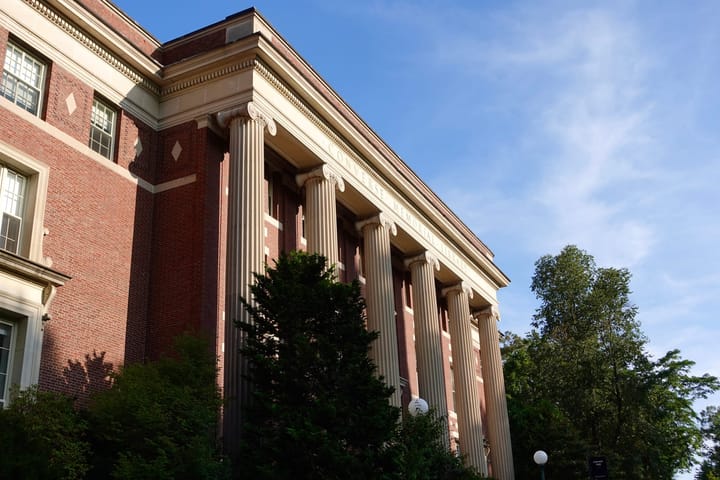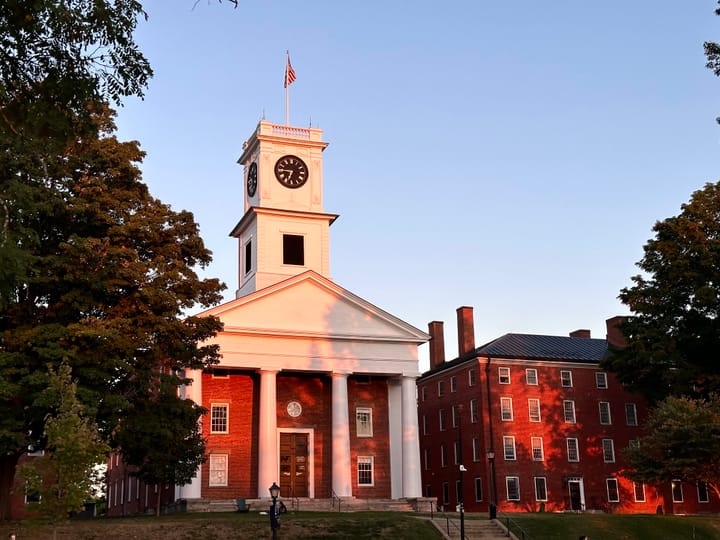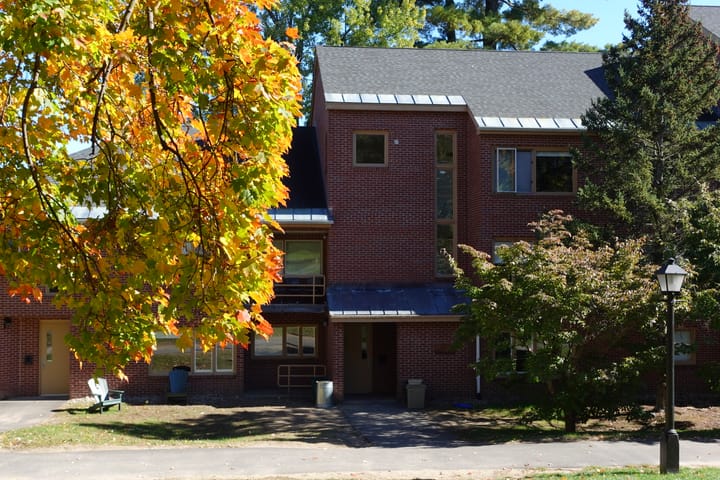Political Violence is the American Tradition
Assistant Opinion Editor Caroline Flinn ’28 traces the nation’s long, often ignored history of political violence — from revolutions and riots to structural oppression — to confront how brutality has shaped democracy itself and to ask whether the cycle can ever truly be broken.
Roughly one month after the murder of Charlie Kirk, I am left reckoning with its aftermath and what it reveals about our political culture. On and off campus, the public reaction was immediate and intense, spanning social media outrage, calls for increased content moderation, and national debates about the responsibilities of social media platforms in preventing violence. Graphic footage of the attack circulated widely, sparking a wave of discussion, condemnation, and even morbid celebration online.
As reluctant as I am to put any more focus on Kirk, his death has become a lens through which the nation’s deepening ideological divides — and the structures that sustain them — come into view. Moreover, the bigger reason we continue to talk about Kirk is not because he was an exceptional figure, but because his death holds a particular symbolic weight: He embodied many of the beliefs, anxieties, and rhetorical styles that define the contemporary right. This moment exposes something deeply rooted in the nation’s political culture; how ideological extremism, digital echo chambers, and political dehumanization increasingly converge into real-world violence.
Political violence should not be understood as an anomaly or a break in the American democratic experiment. Rather, it is one of its defining throughlines, a recurrent theme that threads through moments of national crisis, political upheaval, and social transformation. Kirk’s murder forces a reckoning with this uncomfortable truth that the United States has a longstanding, if uneven, history of conflict where political disagreement has escalated into physical harm.
Political violence is often narrowly imagined as spectacular events: shootings, bombings, riots, or high-profile assassinations that make national news. This understanding, common in much media coverage and popular discourse, overlooks the slower, less visible forms of coercion that shape political life. Political violence is often defined as the deliberate use of power and force to achieve political goals. Academic and progressive definitions take an even broader view. Structural forms of violence — state repression, systemic neglect, police brutality, and institutionalized inequality — are all forms of political violence under this framework. These acts may not make headlines the way an assassination or riot does, but their effects are profound and cumulative. Narrow definitions, by contrast, ignore these slow, normalized forms of coercion, treating political violence as only those events that are visible and spectacular. By acknowledging the full spectrum of political violence — from overt acts of force to everyday structural harm — we gain a more accurate and sobering understanding of American political life.
One cannot deny that the U.S. was born out of political violence. The revolution against Great Britain was not just ideological but violent — militias fought Redcoats, mobs attacked officials, and Loyalists were harassed or killed. Violence wasn’t incidental to America’s founding; it was essential, as independence came through rebellion, not persuasion alone.
This tradition continued through the 19th century. After the Civil War, white supremacists used lynching as a tool of racial terror to control and intimidate Black communities. Anti-immigrant violence flourished as well: Chinese immigrants were massacred in western mining towns, Catholic churches were burned in anti-Catholic and Anti-Irish riots, Know-Nothing mobs targeted Irish and German newcomers. The Haymarket Affair of 1886 saw anarchist leaders executed following a bomb at a labor rally. The Pullman Strike of 1894 and the Ludlow Massacre of 1914 revealed how the state relied on armed force — police, federal troops, and hired gunmen — to suppress worker resistance.
The 20th century brought new iterations. The Red Summer of 1919 saw white mobs carry out anti-Black riots and massacres in dozens of cities, violently reasserting racial control as Black veterans returned from World War I demanding equality. During World War II, Japanese internment uprooted over 120,000 people from their homes in a state-sponsored act of racial violence, justified as national security but driven by prejudice. The Civil Rights Movement was met with brutal state repression — police dogs in Birmingham, troopers beating marchers on the Edmund Pettus Bridge in Selma — and its leaders were assassinated: Medgar Evers, Malcolm X, Martin Luther King Jr. At Kent State University in 1970, the National Guard opened fire on anti-war student protesters, killing four.
Even in contemporary America, the continuity is clear. The Ruby Ridge standoff in 1992 and the Waco siege of 1993 both ended in deadly clashes between citizens and the federal government. They fueled right-wing extremism such as the 1995 Oklahoma City bombing. In the years that followed, the Columbine school shooting in 1999 and the 2015 Charleston church massacre further showed how political and ideological violence manifested in both public and sacred spaces. In Charlottesville in 2017, white supremacists marched with torches and killed a counter-protester. The Jan. 6 insurrection at the Capitol in 2021 showcased the willingness of citizens, fueled by conspiracy and political grievance, to use violence against the very seat of government. This past month, imprisoned immigrants caged inside a Dallas Immigration and Customs Enforcement detention center were shot and killed during an attempted protest over inhumane conditions. And this past week, a journalist was injured during a clash with federal agents at a Manhattan courthouse. The violence will never end.
The list of examples could go on indefinitely; I have not even touched on the countless acts of police brutality or the regularity of 21st century school shootings that have become a common experience of the American landscape. Nor have I mentioned the epidemic of mass shootings in public spaces — nightclubs, churches, movie theaters, grocery stores — that leave communities shattered. Missing, too, are the histories of prison violence and mass incarceration, which strip people of freedom and subject them to systemic abuse. Border policies that separate families and detain migrants in inhumane conditions are another form of political violence often ignored in mainstream narratives. Native communities continue to experience dispossession and violence, from the suppression of water protectors at Standing Rock to the crisis of missing and murdered Indigenous women. Anti-LGBTQ violence, from the Pulse nightclub shooting to raids of gay bars in New York City, further demonstrates how political identities become targets. The list could continue: attacks on abortion providers and clinics, gender-based violence ignored by the state, the militarization of policing in poor and minority neighborhoods.
Understanding this pattern is crucial because it allows us to confront and challenge the conditions that make such violence possible, rather than treating each new incident as an inexplicable anomaly. The murder of Kirk is unacceptable, but it is historically consistent with the patterns that have long defined American democracy. It is part of a long lineage in which political disputes have escalated into physical harm, whether through spectacular acts of violence or the slower, systemic coercion of marginalized groups. Political violence is not the exception but the rule.
The day of Kirk’s shooting was marked by multiple acts of political violence that received vastly different levels of attention. On that same day, a man named Trey Reed was lynched, and a shooting happened at Evergreen High School in Colorado — but these tragedies were largely overshadowed in public discourse. The discrepancy raises urgent questions: What forms of political violence merit national mourning or media attention?
The answer, time and again, reveals the selective lens through which political violence is recognized in the U.S. High-profile figures, particularly white elites like Kirk, are granted symbolic weight in ways that ordinary people — especially those from marginalized communities — are not. Kirk’s murder dominated headlines, elicited public condemnation, and even prompted controversy over lowering flags to half mast, while the lynching and school shooting barely registered in national discourse. Similarly, the murder of Minnesota Representative Melissa Hortman, her husband, and even her dog on June 14, did not receive the same widespread attention. While one could argue that Kirk was more “famous,” fame alone does not determine the value of life. In this sense, political violence is only treated as a national crisis when it targets public figures, while the violence that shapes the everyday lives of ordinary people — especially those from marginalized communities — remains largely ignored. When the nation’s moral outrage depends on a victim’s visibility or status, the very framework of recognition reinforces inequality — it becomes, in itself, a form of political violence.
To say that political violence is an American tradition is not an act of cynicism, nor is it an endorsement. Political violence should horrify us as a tragedy that scars communities, destabilizes politics, and corrodes trust in democracy. History may explain why such events occur, but explanation is not justification. We should never allow familiarity to harden into numbness. If anything, the long record of violence in American life should sharpen our outrage, not dull it.
This becomes especially complicated in the case of Kirk. He is not, by any measure, an easy figure to sympathize with. He stoked the very culture of polarization and violence that ultimately made him a target. Condemning the death of a man who so explicitly targeted women and LGBTQ+ people with his bigotry — communities to which I belong — does not come easily. Yet rejecting his politics does not mean celebrating his death. To celebrate violence against him is to normalize the very logic of violence for everyone else. Once violence is accepted as a legitimate tool against political enemies, it becomes a weapon that can — and will — be turned in all directions.
Political violence in the U.S. is not exceptional — it is foundational, recurring, and normalized. If this is the tradition, what does it mean for the future of American democracy? If we acknowledge that violence is part of our history, we can begin to ask harder, more urgent questions: What would it take to break this pattern? How do we build systems of accountability and justice that make violence less thinkable? And perhaps most difficult of all, if violence has long functioned as a legitimate tool against political enemies — legitimate not in law but in practice — how can we expect people to ensure their own preservation without resorting to it in turn? If those who wield power feel authorized to use violence to maintain it, what moral or strategic alternatives remain for those who are oppressed? To see continuity is not to surrender to inevitability — it is to insist that the cycle can and must be disrupted.





Comments ()